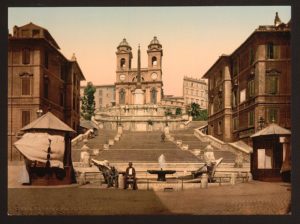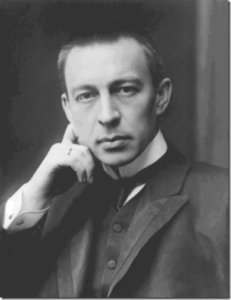On May 9, 11, and 12, the Houston Symphony presents Rachmaninoff’s The Bells, a monumental choral symphony that Rachmaninoff regarded as his best work. In this post, discover how this powerful work, inspired by the poetry of Edgar Allan Poe, prophesied the turmoil Russia would face in the 20th century. Get tickets and more information here.
During the summer of 1912, Mariya Danilova, a cello student at the Moscow Conservatory, discovered Konstantin Balmont’s Russian translation of Edgar Allan Poe’s poem The Bells. She immediately felt that the poem was begging to be set to music, and in her mind there was only one composer to do it. She typed up a copy and sent it anonymously to Sergei Rachmaninoff.

“I read the enclosed poem, and decided at once to use it for a Choral Symphony in four movements,” Rachmaninoff recalled. He set to work composing the piece the following winter while staying in Rome with his family. For composing, he was able to rent “a few quiet, shady rooms” near the Spanish Steps that had served a similar purpose for Tchaikovsky years before (Tchaikovsky had helped discover Rachmaninoff when he was still a student at the Moscow Conservatory). Working at the same desk as his former mentor, Rachmaninoff composed The Bells. “I worked on this composition with feverish ardor,” Rachmaninoff recollected many years later, “and it remains, of all my work, the one I like best….”
It must be noted that Konstantin Balmont’s translation is a rather free one. A prominent poet in his own right, Balmont substantially altered the tone and meaning of Poe’s poems, adding specifically Russian connotative resonances. Namely, the bells of Balmont’s translation have a distinctly Russian sound.
The echoes of bells pervade many Russian compositions. “The sound of church bells dominated all the cities of the Russia I used to know—Novgorod, Kiev, Moscow,” Rachmaninoff explained. “They accompanied every Russian from childhood to grave, and no composer could escape their influence. […] All my life I have taken pleasure in the differing moods and music of gladly chiming and mournfully tolling bells. This love for bells is inherent in every Russian. […] If I have been at all successful in making bells vibrate with human emotion in my works, it is largely due to the fact that most of my life was lived amid the vibrations of the bells of Moscow….In the drowsy quiet of a Roman afternoon, with Poe’s verses before me, I heard the bell voices, and tried to set down on paper their lovely tones that seemed to express the varying shades of human experience.”
Apocalyptic Visions in Russia’s Silver Age
Many have noted the dark mood of The Bells (or Kolokola to give its musical Russian-language title); a review of the November 30 premiere in St. Petersburg read that “Sincerity and spontaneity have always been close to Rachmaninoff’s muse, but against this tragic, sorrowing background, the concentrated shades of hopeless anguish and despair that first appeared in The Isle of the Dead reveal themselves with unusual clarity in The Bells. In Rachmaninoff’s new poem are heard with special force the pessimistic passion and sublime tragedy characteristic of a great and noble heart.”

Even in its happier movements, the shadow of death seems to hover over the piece. This is usually attributed to Rachmaninoff’s melancholic temperament, but historical context likely also influenced the work. The failed democratic revolution of 1905 had seemed Russia’s best chance of escaping autocracy and peacefully resolving the growing social unrest throughout the empire, but Tsar Nicholas II managed to undermine it, reasserting his oppressive and increasingly incompetent rule. A sense of impending doom hung over the final years of the glittering Romanov dynasty. Virtually everyone realized that the dire political situation was untenable, but there was nothing to be done but wait for something to happen.
Artists responded to this environment in a variety of ways; apocalypticism was in the air, as were retreats into symbolism and spiritualism—a heady mixture exemplified by Scriabin’s music. Others turned to Russia’s prehistoric past for inspiration, seeking to renew a decadent and decaying civilization with a jolt of primitivism—Stravinsky’s The Rite of Spring was influenced by these currents (indeed, Stravinsky was working on his revolutionary score at the same time that Rachmaninoff was writing The Bells).
Rachmaninoff, however, remained grounded in the tradition of Romanticism, with its emphasis on memories, psychological insight, and the interior lives of individuals. In The Bells, his musical response to the historical moment seems suffused with what the Germans call Weltschmerz—world-weariness—and yearning for peace. It is perhaps for these reasons that The Bells has a distinctly tragic tone. Given the cataclysmic events that were to befall Russia during the revolution of 1917, the work seems prophetic. Its four movements are like musical tableaux, atmospheric vignettes that “express the varying shades of human experience.”
Memory
The first movement is a joyful memory of a high-spirited sleigh ride through a cold winter’s night—the poem compares the jingling sliver sleigh bells of this movement to children’s laughter. Rachmaninoff uses the enormous orchestra not so much for its power, but for its coloristic effects, evoking not only bell-like sounds, but snow flurries, glittering stars and the thrill of speeding over a wintery landscape:
But even in this carefree movement, there are premonitions of death; the tenor soloist sings that the bells tell of the prophecy of resurrection described by St. Paul in his first epistle to the Corinthians, when “the dead shall be raised incorruptible” on Judgement Day. In the meantime, the dead slumber in oblivion, awaiting resurrection. Rachmaninoff vividly evokes these dreaming souls with a humming chorus.
The tempo slows for the second movement, which describes a marriage ceremony accompanied by the chiming of golden wedding bells. The poem, a sensual meditation on looking into the eyes of the beloved, contains no direct allusions to mortality, but the music is based on the first four notes of the Dies irae, a traditional medieval chant about Judgment Day that became a musical symbol of death. The Dies irae motif appears undisguised at the outset of the movement, and is overlaid with the distinctive sound of Russian church bells. As you can hear in this example, many bells of different sizes ring at once, the lower ones tolling more slowly and the higher ones more quickly. The overlapping patterns can create complex polyrhythms, and bells are often tuned to intervals perceived as dissonant to western ears, such as the tritone.
Rachmaninoff soon transforms this Dies irae motif into a lush, romantic theme. Shortly after the chorus’s first entrance, a solo horn also alludes to the Prelude from Wagner’s Tristan und Isolde, an opera that explores the theme of fatal passion and ends with the famous “Liebestod,” or “Love-death,” in which the heroine dies of love. In Wagner, the consummation of love is linked to death by the feeling of oblivion and freedom from worldly cares that it brings, themes that seem to resonate with the text and music of The Bells. Thus, beneath the soprano soloist’s soaring lines are musical premonitions of what unfolds in the rest of the work.
Prophecy
The third movement transitions from the world of memory to that of prophecy. The bells of this movement are brazen alarm bells that cry, weep, and shout as a terrifying fire threatens to engulf the earth. The movement begins quietly—as if from a single spark—but quickly grows into an intense orchestral conflagration. It is in this orchestral introduction that one most clearly hears the distinctive sound of Russian church bells. The music builds to a harrowing climax as the insatiable fire declares its intent to reach the moon. In its historical context, the music seems to presage the violence that would overtake Russia during the revolution of 1917 and the subsequent civil war. Indeed, Rachmaninoff’s own beloved home in the Russian countryside would be burnt to the ground during this turbulent period.
The horror of the alarm bells gives way to the grim tolling of a funeral bell in the final movement, which begins with a bleak English horn solo. “The necessary funereal finale had the precedent of Tchaikovsky,” Rachmaninoff noted, referring to the slow, deathly finale of Tchaikovsky’s Symphony Pathétique. Indeed, Rachmaninoff wrote Tchaikovsky’s initials into the autograph score at the point where the baritone soloist and chorus sing “For we sob as we recall our eyes will shut, our heart be still.” Rachmaninoff biographer Barrie Martyn suggests that the descending, scalar melody in this passage was adapted from Act II of Tchaikovsky’s opera The Queen of Spades, although many melodies Tchaikovsky composed in his final years have a similar descending shape (consider this theme from his Pathétique Symphony). The movement builds to a harrowing climax as the singers describe the hideous laughter of the supernatural figure ringing the iron bell in the church tower.
After this intense passage, the violas begin playing a simple, descending figure that Rachmaninoff first heard many years before. “One of my fondest childhood recollections is associated with the four notes of the great bells in the St. Sophia Cathedral of Novgorod, which I often heard when my grandmother took me to town on church festival days,” Rachmaninoff recalled. “The bell ringers were artists. The four notes were a theme that recurred again and again, four silvery weeping notes veiled in an everchanging accompaniment woven around them. I always associated the idea of tears with them.” Rachmaninoff incorporated this four-note figure into the third movement of his First Suite for Two Pianos (inspired by Tiuchev’s poem, Tears), and it appears again in The Bells as the soloist and chorus sing their final words. At the end, the orchestra alone offers listeners hope with a warm melody for strings. The Bells ends with a plagal cadence, the traditional harmonization of the word “Amen.”
Don’t miss Rachmaninoff’s The Bells on May 9, 11, and 12! Visit houstonsymphony.org for tickets and more information.
We want to hear from you! Tell us what you think in the comments below.



